Distinguishing Lipedematous Scalp, Lipedematous Alopecia, and Diffuse Alopecia Areata
January 2019
in “
Skin appendage disorders
”

TLDR The conclusion is that it's important to tell apart alopecia areata from lipedematous alopecia for proper treatment, as alopecia areata can be reversed.
The document presents a case report of a 52-year-old woman diagnosed with lipedematous scalp (LS) and alopecia areata, which is characterized by a thickened scalp layer and hair loss, respectively. The presence of CD3+ T-lymphocytes around the hair bulb confirmed alopecia areata, which was successfully treated with diphenylcyclopropenone contact immunotherapy, resulting in hair regrowth. The authors stress the importance of differentiating alopecia areata from lipedematous alopecia (LA) for accurate diagnosis and treatment, as alopecia areata is reversible. They suggest that LS and LA may be different expressions of the same condition and emphasize ruling out other causes of alopecia to decrease patient morbidity.



